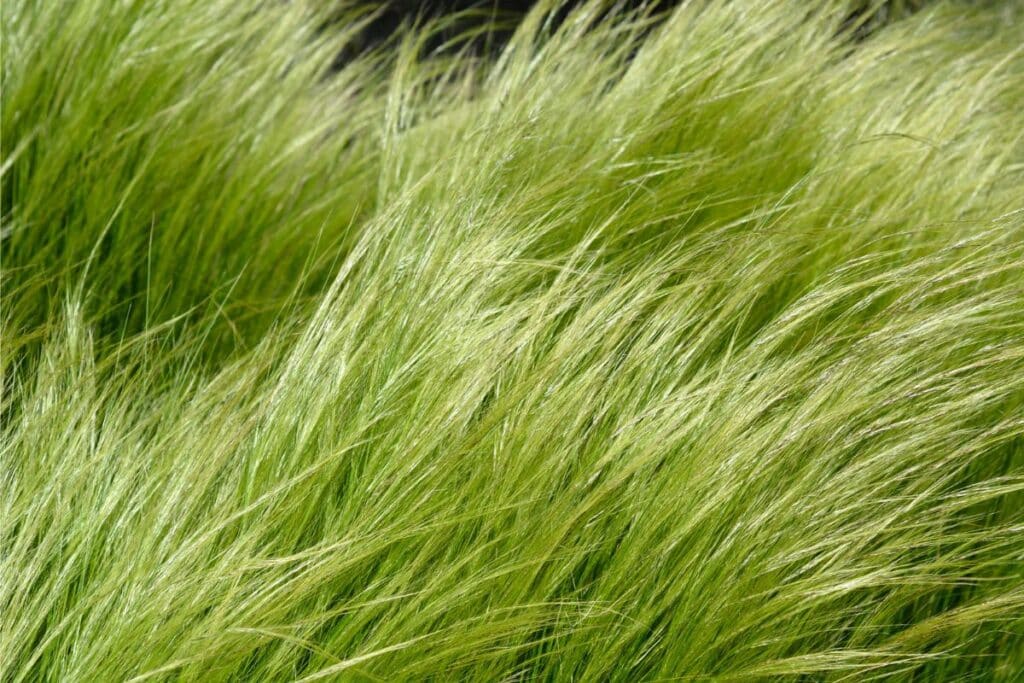Mexican feather grass (Nassella tenuissima) is a favorite among many grass lovers because the silvery-green thread-like leaves can give landscapes a graceful and wavy appearance. The hair-like leaves of these perennial grasses are quite captivating and can soften up any space.
Despite its appealing look, you do need to be cautious about growing Mexican feather grass.
Mexican feather grass is listed as an invasive species in certain parts of the United States like California. It also made its way to Australia and is classified as highly invasive in South Australia.
This is because these grasses have an extensive seed production rate and impact native plant species. It also offers little nutritional value to grazing animals and the dry grass can pose a fire risk.
It is best to only grow these grasses in areas where they are not listed as invasive and to keep them for ornamental purposes only. As ornamental grass, they can be used to create all sorts of showy spaces.
Let’s take a look at how to grow and care for this charming grass variety.
Plant Facts
| Scientific name | Nassella tenuissima |
| Common names | Mexican feather Grass, Texas tussock, fine-stem tussock, white tussock, or ponytail grass, finestem needlegrass, and fine-leaved nasella |
| Family | Poaceae |
| Plant Type | Ornamental Grass |
| Height and Width | 1–2 ft. tall, 1–2 ft. wide |
| Origin | Southern Central U.S.A. to Mexico and Argentina |
| Flower colors | Gold/yellow, gray/silver, or white with cream/tan seed heads |
| Foliage color | Gray/silver or green hair-like leaves |
| Sun Exposure | Full sun to part shade |
| Soil Type & pH | Well-drained clay, loam, or sandy soil and grows in neutral, acidic, or alkaline soils |
| Special features | Low Maintenance, Good for containers, rock gardens, woodlands, or rocky slopes |
What Does Mexican Feather Grass Look Like?
It is impossible not to fall in love with the charming look of this fine textured grass. Mexican feather grass forms long whispy leaf blades with soft breezy flowers or plumes on top. The grasses stand upright to create a soft ponytail look.
These beautiful plants can appear a little bit different during different growing stages.
The first green shoots will start appearing in spring and during its growing season, the grass has lime-green foliage with whispy white or golden feather-like plumes.
From late summer to fall, these grasses will produce lots of flowers in golden or gray hues. The deciduous grasses will go dormant in winter but will still offer lots of winter interest as the green foliage transforms into golden hues.
Where Does Mexican Feather Grass Grow?
These grasses are native to the Southwest US, and the mountains in west Texas, Mexico, and Argentina but they have become widely used throughout the US and even spread as far as Australia.
Does Mexican feather grass spread?
This grass variety can spread rapidly because it will produce tens of thousands of seeds that can easily be dispersed by wind. The seeds also have a high germination rate and can quickly become a problem in natural spaces.
These grasses are quick to take to rocky spaces and they can easily grow on rocky hillsides, roadsides, in garden beds or they can be planted in containers.
How to Grow Mexican Feather Grass
If you want to use this showy grass to create a focal point in your garden then it is best to find out more about its growing habits so you can take good care of your new plants.
Propagation
This grass is pretty easy to propagate because it can be planted by sowing seeds or by dividing the mature plumes.
If you are propagating by dividing the plumes then it is best to start in early spring before the new green shoots start to appear. You can dig up the plumes and cut them into smaller bits before planting them again.
The grass is very easy to grow from seed and it can even self-sow all over your garden without any extra effort from your side. To plant this ornamental grass from seed, you can simply use a small pot with some seed starting mix. Place the seeds on the soil and lightly cover them with sand. Keep the seeds moist and they will soon start to sprout.
Soil
This grass variety is very flexible in terms of soil. It can grow in just about any type of well-drained soil including chalk, clay, loam, and sandy soil types and it isn’t bothered about soil pH levels at all.
Pruning
You don’t need to prune the grass during its growing season because the clumps look their best if they are left to flower. Some gardeners do prefer to trim away dead flowers or overgrown stems to keep the plumes appealing during their dormancy stage.
It is best to give these grasses a good prune in early spring before the first new spots start arriving. To do this, you can use sharp garden shears to clear away all the old foliage. You can cut back the dead grass about 3 – 4 inches above ground level.
How to Care for Mexican Feather Grass
Mexican feather grass is one of the easiest ornamental grasses to care for. Here is a quick look at a simple care guide for these charming grasses.
Water
This hardy grass variety can be very drought tolerant but it can also handle lots of moisture. New plants should be kept moist or watered weekly for their first growing season. Once the plants matured, you hardly ever need to water them because they can grow well in dry soil and dry periods.
In particularly warm areas, you can water the plants once a week or when the soil is completely dry.
Sunlight
These grasses grow best in a full-sun position with 6 hours of direct sunlight per day. They can, however, also grow well in a partial shade position with 2 – 6 hours of direct sunlight. A partial shade position is ideal if you are growing these grasses in warmer regions.
Temperature and Humidity
This hardy grass can survive in extremely cold temperatures of as low as 0 degrees F because it will become dormant for winter. It can also be heat tolerant and will easily grow during warm summers.
Feather grass prefers dry soil and dryer climates but it will also grow quite well in high humidity levels with moist soil.
Fertilizer
There is no need to fertilize this interesting plant because Mexican feather grass prefers poor soil conditions. If the grass is planted in containers then you can simply add a little bit of plant food every season to boost their growth.
Some gardeners prefer to add a good layer of compost over their soil to nourish and boost the growth of these grasses.
Pests and Diseases
You won’t encounter too many pests, diseases, or issues with this grass because it is mostly deer and rabbit resistant and not too vulnerable. Here is a quick look at some of the issues you can keep an eye out for.
Aphids
Aphids are sap-seeping pets that can sometimes plague your beautiful grasses. These pests tend to attack new green shoots and can cause the leaves to become mutilated. Aphids can be naturally controlled by predatory insects like ladybugs or you can control them with pesticides.
Leaf spot
Leaf spot is a bacterial disease that causes brown or rust-colored spots on the plant foliage. This fungal disease can be treated by clearing away the affected foliage and by using a fungicide on the plants.
Overgrowing
Mexican feather grass has a rapid growth rate and can take over your garden. You can keep the grass in check by pulling up some plantings in spring or whenever they get out of hand.
Flattening
These grasses can start to lay flat if they don’t receive enough water if they are over-fertilized, or if they are grown in too much shade.
Mexican Feather Grass Companion Plants
These beautiful grasses can look charming if they are mass planted in large spaces. You can grow Mexican feather grass with companion plants so the fine texture and vivid leaf color will be accentuated.
You can grow Mexican feather grass with other ornamental grass species like maiden grass, feather reed grass, or blue oat grass to create interesting texture-rich garden beds.
These beautiful grasses can also be grown with flowering plants like white coneflowers, Russian sage, lavender, or blanket flowers to create a wildflower garden effect.
Mexican Feather Grass Landscaping Ideas
These ornamental grasses are popular in landscape designs because they can be used in different ways to create showy garden spaces. Let’s take a peek at some of the most popular ways these grasses are used.
Borders or Hedges
The showy grasses are great for creating dense and fine textured borders or hedges. You can plant them alongside your driveway, on the edge of garden beds, or alongside rocky walls to create an interesting living barrier.
Slopes
The grass is excellent for adding lots of vertical interest to rocky slopes, terraces, or alongside garden steps or patio steps. You can plant them in clumps on these sloped spaces and mix in other texture-rich plant species to create a showy effect.
Dry Gardens
Because the plant species is drought tolerant, it can easily be used in xeriscape projects or rainfall gardens.
Conclusion
Mexican feather grass can be a terrific ornamental grass to add to your garden if you want to soften up the look of your landscape. It is, however, best to keep your hand on these grasses and avoid planting them in wild open spaces because they can disrupt native plants.
We hope that this guide gave you lots of inspiration and that you now have plenty of ideas on how to use, plant, and care for this interesting plant.
References
Reference List
Gerald Klingman – Plant of the Week: Mexican Feather Grass – https://www.uaex.uada.edu/yard-garden/resource-library/plant-week/mexican-feathergrass-3-23-07.aspx
Melissa G. Womack – Mexican Feather Grass: Invasive Beauty can be Deceiving – https://ucanr.edu/blogs/blogcore/postdetail.cfm?postnum=14457
North Carolina Extension Gardener Plant Toolbox – Nassella tenuissima – https://plants.ces.ncsu.edu/plants/nassella-tenuissima/
Queensland Government – Mexican Feather Grass – https://www.business.qld.gov.au/industries/farms-fishing-forestry/agriculture/biosecurity/plants/invasive/restricted/mexican-feather-grass
Oklahoma State University – Mexican feather grass – https://extension.okstate.edu/programs/oklahoma-proven/plant-profiles/mexican-feather-grass.html
Government of South Australia – Mexican Feather grass – https://cdn.environment.sa.gov.au/landscape/docs/hf/mexican-feather-grass-identification-fact.pdf
Close
*image by nahhan/depositphotos







